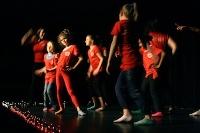Girls in Motion Creates Support Network
February 11, 2013
Elizabeth Kuhr

Nine years ago, while she was teaching her daughter’s middle school co-ed soccer team, Professor of Dance Ann Cooper Albright noticed a change. Girls who had been assertive on the field were beginning to pull back.
Cooper Albright had been reading about what scholars were calling “‘the confidence gap’ in middle school girls, meaning that many girls who are engaged and enthusiastic in elementary school become less willing to put themselves out there in middle school,” explains Cooper Albright. “I was seeing the physical equivalent of that on the soccer field… I felt if I could address this on a physical level — while still having fun — then it might have an impact in terms of schoolwork and social leadership.”
Thus began Girls in Motion (GIM), an after-school program for girls at the Langston Middle School in Oberlin.
“There are cultural conventions that get scripted on the body,” says Cooper Albright. “But as a dancer, I know that you can intervene and bodies can often be retrained.”
The program is a mentorship between Oberlin College students and adolescent girls in the Oberlin public school system. “We hope to empower girls to be comfortable with their own bodies,” says Anita Peebles, a junior religion and environmental studies double major and GIM organizer who joined to help to provide an opportunity for young Oberlin girls that hadn’t been available to her. “I recognized that when I was a middle school girl, I could have benefitted from a program that had these aims and really wanted to build relationships.”
GIM’s motto, “Move Smart, Talk Smart, Be Smart,” is indicative of the program’s philosophy. An average of six to 12 girls from Langston Middle School usually participate each semester, says Peebles. Through twice-weekly classes with instruction in movement forms such as dance and yoga and activities including theater and improv exercises, GIM “provides an outlet for expression and creativity that links your body and your mind together,” says fellow organizer and sophomore psychology and anthropology double major Noa Fleischacker.
In addition, the program gives the middle school students a support network, providing “a safe space in questioning things about growing up and providing positive female support,” says Peebles.
To celebrate their achievements, GIM holds at least two annual performances — one in December at the Cat in the Cream, and another in May’s Big Parade, with a dance-off at the bandstand. This year, the group will have an additional performance on April 29 in the Cat in the Cream.
In the nine years that GIM has been in operation, the program has experienced repeated revitalization through the enthusiasm of its dedicated mentors, not to mention continued support from administrators in the college — including those in the Bonner Center for Service Learning and the Oberlin Young Educators — and the Oberlin City Schools, including Nadia Johnson, the guidance counselor at Langston Middle School, and John Schroth, Oberlin School superintendent.
This past fall, Fleischacker, Peebles and third organizer Leila Goldstein, a junior majoring in theater and comparative American studies, made several key changes to expanding the program — they successfully began GIM programs in Prospect Elementary School and the Oberlin Boys and Girls Club, and offered an Experimental College (ExCo) class for Oberlin College students interested in becoming mentors. The participants completed readings on dance and pedagogy, participated in weekly class discussions, and spent at least one hour mentoring per week. The three ExCo leaders trained nine additional mentors, and through the course, students “get real life experience, real hands-on work negotiating how to bring ideas into practice,” says Cooper Albright.
The GIM organizers also succeeded in expanding the program into Prospect Elementary School and the Oberlin Boys and Girls Club
As well as serving as a support system for Oberlin youth, GIM mentors are there for one another. “It’s not only about the relationship of the college mentors with the students,” says Peebles, “but it’s about their relationships with each other.”
The success of GIM is largely thanks to its passionate and dedicated mentors. Although expansion of the program might be in their future, “We’re mostly interested in strengthening the places that we’re in now,” says Peebles.
To learn more about GIM, visit their website.
You may also like…
Oberlin Celebrates Homecoming Weekend with Cluster Reunions and Title IX 50th Anniversary Tribute
Tailgate, athletic events, performances, and reunion activities are just a few of the highlights.
Take It for Granted
As the excitement of the school year begins, it can seem like Oberlin is so full of opportunities that it’s hard to remember them all. But there are a few that you may not have heard about yet, and...
This Week in Photos: Beautiful
It’s Saturday night in March and there’s a pulsating glow spilling from the windows of the Root Room in Carnegie Building. Inside, rows of spectators line the perimeter of a long narrow stage. Oberlin’s most anticipated fashion show begins as cheers swell when models, draped in creative attire, take their turn down the walk. This is a signature event during Black History Month. It also serves as inspiration for this week’s photo series.


